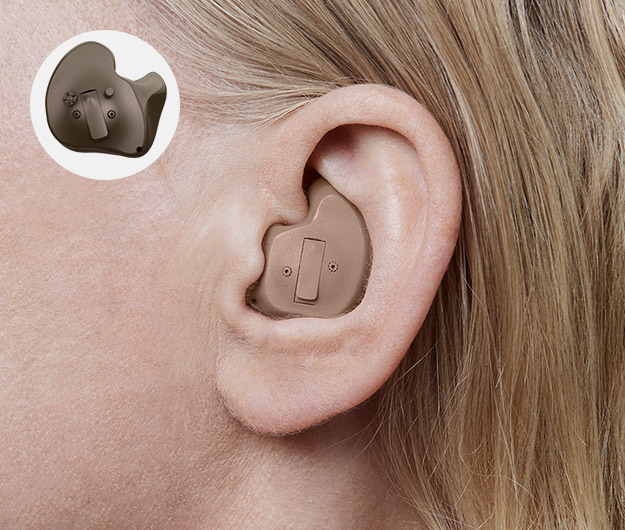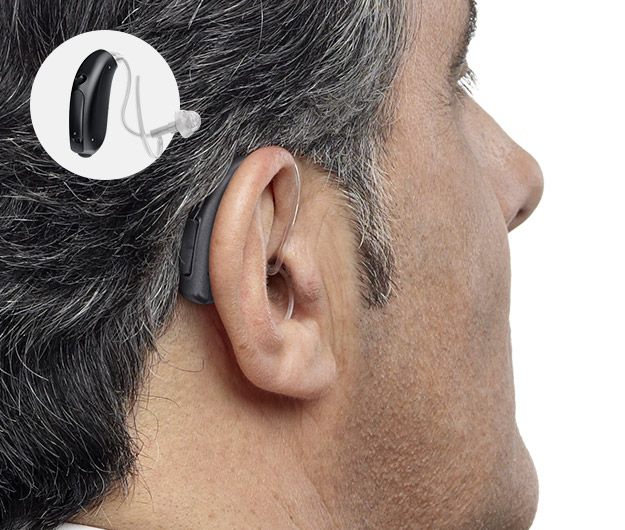
The 5 main types of hearing aids and how they work
Knowing the types of hearing aids out there makes it easier to find one that fits your lifestyle and hearing needs. Here’s a quick look at the five main types that hearing healthcare professionals categorize hearing aids into—Behind-the-Ear (BTE), Receiver-in-Canal (RIC) / Receiver-in-the-Ear (RITE), In-the-Ear (ITE), In-the-Canal (ITC) / Completely-in-the-Canal (CIC), and Invisible-in-the-Canal (IIC)—each with features to suit different hearing levels and lifestyles.
- Behind-the-Ear (BTE): Sits behind the ear, with sound delivered through a tube to a custom earpiece in the ear. Ideal for moderate to profound hearing loss, BTE hearing aids offer robust features, long battery life, durability, and are easy to handle.
- Receiver-in-Canal (RIC) / Receiver-in-the-Ear (RITE): The main device rests behind the ear, while a receiver (speaker) sits in the ear canal for natural sound quality. Suited for mild to severe hearing loss, these hearing aids are comfortable, discreet and versatile.
- In-the-Ear (ITE): Custom-fitted to sit fully in the outer ear, ITE hearing aids are easy to handle, offer good battery life and are suitable for mild to severe hearing loss.
- In-the-Canal (ITC) and Completely-in-the-Canal (CIC): Smaller style of hearing aid with ITC sitting in the outer ear and CIC fitting deeper within the ear canal. Great for mild to moderate hearing loss, these options are compact and less visible.
- Invisible-in-the-Canal (IIC):The smallest option, positioned deep in the ear canal for near invisibility. Best for mild to moderate hearing loss, IIC hearing aids offer a discreet hearing solution.
Finding the right type of hearing aid
Ready to improve your hearing but not sure what type of hearing aid is best for you? You’ve come to the right place. On this page you will get an overview of:
- All the basic types of hearing aids
- Facts and features to consider when choosing the right type for you
Additionally, you are always welcome to visit one of our hearing clinics, where we will be happy to show you some of the most popular hearing aid models available.

Hearing aid type: In-the-ear
There are five types of in-the-ear hearing aids, ranging from the invisible-in-the-canal to the full shell in-the-ear hearing aid:
- Suited for mild to severe hearing loss
- The smallest hearing aid style is virtually invisible inside the ear
- The full shell hearing aid style fits inside the outer bowl of the ear
- All types are custom-made to suit the shape of your ear, ensuring optimal comfort and sound quality
- Some models offer Bluetooth® technology so that you can stream sound from your phone, computer, or TV
4 facts about in-the-ear hearing aids
Browse through in-the-ear hearing aid types
Tips from an audiologist
Find a hearing clinic with in-house audiologists or specialists who provide counseling based on your specific needs. A specialized hearing clinic will have several hearing aid types and brands, allowing you to find the most optimal solution for you.


Hearing aid type: Behind-the-ear
These types are the most popular hearing aids for people with hearing loss.
- Suited for mild to profound hearing loss
- All components are housed behind the ear with a clear tube leading to an earpiece that fits inside your ear
- Modern hearing aids are sleeker and slimmer than older versions and are great for people with dexterity challenges or visual impairment
- While modern behind-the-ear models are very discreet, they are not as invisible as in-the-ear hearing aids
- Feature powerful technology and typically have more feature options than in-the-ear hearing aids
4 facts about behind-the-ear hearing aids
Browse through behind-the-ear hearing aid types
Invisible hearing aids
Modern hearing aids are more discreet than ever before. In fact, many hearing aids are practically invisible. Designed to be especially discreet, the smallest variants of in-the-ear hearing aids are placed inside the ear canal. Examples of these include:
- Invisible-in-the-canal hearing aids
- Completely-in-the-canal hearing aids
These types are considered to be the most invisible hearing aids available. Since they sit completely inside your ear canal, people are unlikely to notice them.
Several types of behind-the-ear hearing aids are also very discreet and will not be particularly noticeable when worn. Behind-the-ear hearing aids allow for more features and advantages, making them the preferred type of hearing aid for many wearers.

Rechargeable hearing aids
Some hearing aids offer the convenience of rechargeable batteries. An easy overnight charge allows for hassle-free maintenance by eliminating the need to regularly replace batteries. Having rechargeable hearing aids removes the inconvenience of having to change batteries, which is a benefit to all, especially for those with dexterity challenges.
Bluetooth® hearing aids
If you choose a hearing aid with Bluetooth® technology, you can connect it to your TV so that you can hear the TV audio directly in your hearing aid, making it easier to hear your favourite TV show.
It is also possible to connect a hearing aid to other Bluetooth® devices, such as mobile phones, computers, and tablets. If you have an iPhone, then your Bluetooth® hearing aids can double as a wireless headset, allowing you to listen to music or make hands-free phone calls.

Book a FREE, 30-day hearing aid trial
What to consider when researching hearing aid types
FAQs about types of hearing aids
Guide to choosing hearing aids
There are several factors that can determine which hearing aid is the right model for you. This 3-step guide will help you understand how to find the best hearing aid for you.













